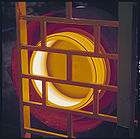
Centrifugal casting (industrial)
Encyclopedia

Casting
In metalworking, casting involves pouring liquid metal into a mold, which contains a hollow cavity of the desired shape, and then allowing it to cool and solidify. The solidified part is also known as a casting, which is ejected or broken out of the mold to complete the process...
technique that is typically used to cast thin-walled cylinders. It is noted for the high quality of the results attainable, particularly for precise control of their metallurgy and crystal structure. Unlike most other casting techniques, centrifugal casting is chiefly used to manufacture stock materials in standard sizes for further machining, rather than shaped parts tailored to a particular end-use.
Process
In centrifugal casting, a permanent mold is rotated continuously about its axis at high speeds (300 to 3000 rpm) as the molten metal is poured. The molten metal is centrifugally thrown towards the inside mold wall, where it solidifies after cooling. The casting is usually a fine-grained casting with a very fine-grained outer diameter, owing to chilling against the mould surface. Impurities and inclusions are thrown to the surface of the inside diameter, which can be machined away.Casting machines may be either horizontal or vertical-axis.http://www.centrifugalcasting.com/technical.htm Horizontal axis machines are preferred for long, thin cylinders, vertical machines for rings.
Most castings are solidified from the outside first. This may be used to encourage directional solidification
Directional solidification
Directional solidification and progressive solidification describe types of solidification within castings. Directional solidification describes solidification that occurs from farthest end of the casting and works its way towards the sprue...
of the casting, and thus give useful metallurgical properties to it. Often the inner and outer layers are discarded and only the intermediary columnar zone is used.http://www.metalwebnews.com/howto/casting/casting.pdf
Features of Centrifugal Casting
- Castings can be made in almost any length, thickness and diameter.
- Different wall thicknesses can be produced from the same size mold.
- Eliminates the need for cores.
- Resistant to atmospheric corrosion, a typical situation with pipes.
- Mechanical properties of centrifugal castings are excellent.
- Only cylindrical shapes can be produced with this process.
- Size limits are up to 3 m (10 feet) diameter and 15 m (50 feet) length.
- Wall thickness range from 2.5 mm to 125 mm (0.1 - 5.0 in).
- Tolerance limit: on the OD can be 2.5 mm (0.1 in) on the ID can be 3.8 mm (0.15 in).
- Surface finish ranges from 2.5 mm to 12.5 mm (0.1 - 0.5 in) rms.
Benefits
Cylinders and shapes with rotational symmetry are most commonly cast by this technique. "Tall" castings (in the direction of the settling force acting, usually gravity) are always more difficult than short castings. In the centrifugal casting technique the radius of the rotation, along which the centrifugal force acts, replaces the vertical axis. The casting machine may be rotated to place this in any convenient orientation, relative to gravity's vertical. Horizontal and vertical axis machines are both used, simply to place the casting's longest dimension conveniently horizontal.Thin-walled cylinders are difficult to cast by other means, but centrifugal casting is particularly suited to them. To the rotation radius, these are effectively shallow flat castings and are thus simple.
Centrifugal casting is also applied to the casting of disk and cylindrical shaped objects such as railway carriage wheels or machine fittings where the grain, flow, and balance are important to the durability and utility of the finished product.
Providing that the shape is relatively constant in radius, non circular shapes may also be cast.
Materials
Typical materials that can be cast with this process are ironIron
Iron is a chemical element with the symbol Fe and atomic number 26. It is a metal in the first transition series. It is the most common element forming the planet Earth as a whole, forming much of Earth's outer and inner core. It is the fourth most common element in the Earth's crust...
, steel
Steel
Steel is an alloy that consists mostly of iron and has a carbon content between 0.2% and 2.1% by weight, depending on the grade. Carbon is the most common alloying material for iron, but various other alloying elements are used, such as manganese, chromium, vanadium, and tungsten...
, stainless steel
Stainless steel
In metallurgy, stainless steel, also known as inox steel or inox from French "inoxydable", is defined as a steel alloy with a minimum of 10.5 or 11% chromium content by mass....
s, glass
Glass
Glass is an amorphous solid material. Glasses are typically brittle and optically transparent.The most familiar type of glass, used for centuries in windows and drinking vessels, is soda-lime glass, composed of about 75% silica plus Na2O, CaO, and several minor additives...
, and alloys of aluminum, copper
Copper alloys
Copper alloys are metal alloys that have copper as their principal component. They have high resistance against corrosion. The best known traditional types are bronze, where tin is a significant addition, and brass, using zinc instead...
and nickel.
Two materials can be cast together by introducing a second material during the process.
Applications
Typical parts made by this process are pipes, boilers, pressure vessels (see autofrettageAutofrettage
Autofrettage is a metal fabrication technique in which a pressure vessel is subjected to enormous pressure, causing internal portions of the part to yield and resulting in internal compressive residual stresses. The goal of autofrettage is to increase the durability of the final product...
), flywheels, cylinder liners and other parts that are axi-symmetric. It is notably used to cast cylinder liners and sleeve valve
Sleeve valve
The sleeve valve is a type of valve mechanism for piston engines, distinct from the usual poppet valve. Sleeve-valve engines saw use in a number of pre-World War II luxury cars and in USA in the Willys-Knight car and light truck...
s for piston engines, parts which could not be reliably manufactured otherwise.

